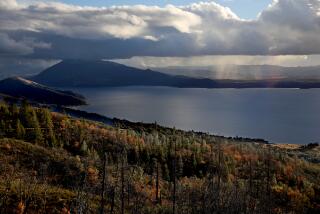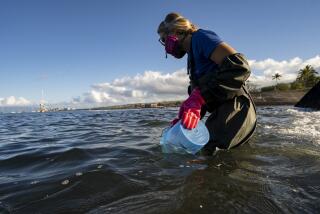Blue Florida Keys Reflect New Hew: Dirty Black : Pollution: Their sweet tropical aroma is a barnyard stink. Their coral reefs have cancer. Unless an ecosystem is saved soon, an economy will die as well.
- Share via
FLORIDA BAY, Fla. — Amy Knowles steers her skiff near an area of dead mangroves in Florida Bay, searching in vain for clear water.
Butterflies, white specks of life, flutter in ironic beauty among the dead and dying trees, but the bay itself, once clear as tap water, is lifeless. Once near Islamorada in the Keys the water was aqua, then it turned green, now it is black as coffee.
The tide is out. Clumps of dead turtle grass lie on the surface. A barnyard smell permeates the fetid air, normal ammonia discharge gone haywire in what is essentially a compost stew.
It is the stench of a dying ecosystem.
More than 100,000 acres of sea grass and sponges are dead in the bay. This has created a mushy under-layer that feeds algae blooms. The slime smothers life that used to nurture lobsters, pink shrimp, a host of fin fish and all types of birds.
“Nobody paid any attention until last year when the blooms started to affect the coral reef track,” Knowles said. “Then it was something you couldn’t close your eyes to.”
The blooms eat up the 1,000-square-mile fish nursery off the edge of the Florida peninsula like a cancer. Even worse, researchers believe the bay’s altered water is spreading under channels beyond the Keys into the Atlantic Ocean. On North America’s only coral barrier reef, coral is dying at an alarming rate.
Many blame much of the bay’s problem on the diversion of fresh water from the Everglades, which is also having devastating consequences on the mainland.
While environmentalists, regulators and farmers argued in court over who should pay to clean up and restore the Everglades, the rest of the watershed ecosystem--Florida Bay and the colorful coral reefs--were ignored until just recently.
Now they are on the verge of collapse.
Gov. Lawton Chiles angered environmentalists by pushing legislation that they believe will delay cleaning up pollution in the Everglades by a decade. Under the $685-million restoration plan, a system of giant marshes will be created to filter out pollution from sugar growers and vegetable farmers in South Florida.
The legislation includes a plan to put more fresh water into Florida Bay by flooding some farmland south of Miami--a plan already facing fierce opposition from farmers.
Knowles, in her skiff, is determined to find some clear water on this four-hour trip around Florida Bay. She finds some around Rabbit Key Basin, but says it “really wasn’t that clear.”
She should know. She has fished in these parts for more than a decade and teaches people how to fly-fish. She scans the water searching for tarpon.
“It’s the most exciting thing I can think of,” she says when she spots a school of the shimmering, big-eyed fish--some 5 feet long--hanging out near a dock.
The water at Rabbit Key Basin may not be up to the Knowles standard, but it is at least a glimpse of what Florida Bay looked like just a few years ago: miles of water tinged tawny by the mangroves on mud islands, but always clear enough to see the sea grass sway beneath.
“It was so wonderful to go exploring back here,” Knowles says as she navigates her skiff over the flats. “Now I get very depressed.”
Residents of the Florida Keys make their money from the water. The bay produces $420 million a year in commercial fish and shrimp catches, about one-fifth of Florida’s total harvest.
If the ecosystem fails, it will take an entire economy with it.
Karl Lessard, a fisherman, has trolled the waters for 24 years, searching mainly for lobsters and stone crabs.
“Out of Marathon in the early 1970s, there were 25 shrimp boats,” he said. “We no longer have a single shrimp boat.”
Lessard estimates that 20% to 35% of commercial fishermen have left the Keys in the last decade in search of better waters or a new profession.
Fishermen say their catch has declined as much as 80% since 1981 on species such as pink shrimp. Ironically, pink shrimp catches increased 64% last year for the first time since the algae blooms appeared in 1987. The shrimp, however, were scrawny, and some believe the catch increased because fish no longer could see the shrimp in the murky blooms.
Lessard first noticed the greening of the bay in the 1970s in an area he used to fish that’s now known as the Dead Zone. These days, he said, he must wake at 3 a.m. and take his boat 30 to 50 miles out to catch enough fish to make a living.
And the problem is spreading.
Lessard now sees the algae blooms hurting recreational fishing and other industries vital to the Keys’ economy. This spring, scuba-diving trips to the reef were canceled when visibility dropped to 5 feet, he said.
Rep. Peter Deutsch (D-Fla.) said a study by his office found 5,000 jobs could be lost if the environment in the Keys collapses.
“People like fishermen are saying, ‘I’m not making as much money.’ Divers say, ‘The water is dirty.’ Guides say, ‘I’m losing 10% of my business,’ ” Deutsch said.
As fresh water flowing to the Everglades is diverted to farmland and to the burgeoning cities of southeast Florida, the effects trickle to the bay.
Researchers have linked the sea grass die-offs and algae blooms to pollution and man-made changes that have reduced the flow of fresh water to about one-fifth of what nature intended.
To rescue the bay, environmentalists are lobbying the government to buy up farmland south of Miami and flood it in hopes of returning some type of freshwater flow.
Keith Rampley and Michelle Harrison of England had just finished canoeing among the mangroves at John Pennekamp State Park, Florida’s 178-square-mile nautical preserve on Key Largo. They had been to Florida before and came back for one reason.
“We came here particularly to see the reef,” Rampley said. “But if we had heard there wasn’t that much to see, if the fish weren’t coming and coral was dying, what’s the point of coming?”
Sentiments like that are the Keys’ worst nightmare. The reef and the marine life it supports are a major tourist lure.
“The reef is an international resource,” said DeeVon Quirolo of Reef Relief in Key West, “and it’s dying before our eyes.” He blames farm runoff and sewage from the Keys for killing the coral.
The barrier reef stretches for 128 miles, from near Miami to the end of the Keys. About 1 million divers visit the reef annually for a firsthand look at the bounty of colorful fish and the coral varieties that range from purple fans to stolid brain-like caps.
Scott Marr, owner of Del Mar Resort in Key Largo, said the people who either fish Florida Bay or dive the barrier reef generate $2 billion a year for the Keys and provide about 75% of Monroe County’s jobs.
“The first thing that happens is Florida Bay goes, then coral reefs die, then it’s going to impact Miami and all of South Florida,” Marr said. “I can’t believe it won’t impact the entire state because people come here to see more than Mickey Mouse and Donald Duck.”
Just so. Next to the Orlando area’s Walt Disney World, the Keys are the most-visited spot in Florida.
There’s a rub. While tourism drives the Keys’ economy, tourists are part of the problem.
“As the dive industry has grown, there are bigger boats with more people, and they are using more and more of the reef system,” said Walter Jaap, who works for the Florida Marine Research Institute.
More to Read
Sign up for Essential California
The most important California stories and recommendations in your inbox every morning.
You may occasionally receive promotional content from the Los Angeles Times.










